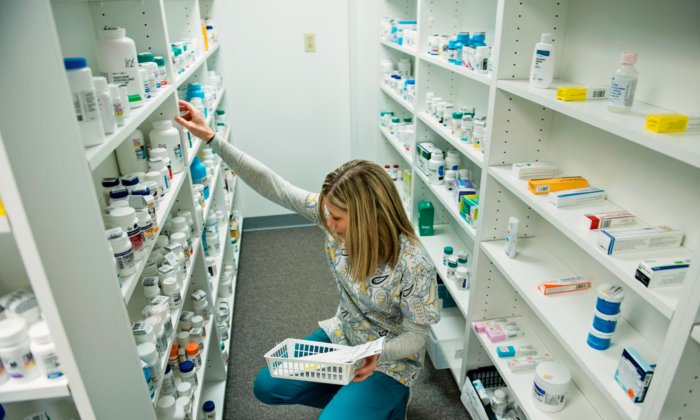Can We Rely on Our Prescriptions? Reassessing the Pill Bottle
Keeping Trust in Our Prescription Medications
With frequent recalls and ever-present risks, the trustworthiness of our prescriptions is under the microscope. Are you getting the right dose of the right medication? Even if you read your label properly and follow the prescription to the letter, you might be suffering the effects of systemic failings in the health care system that contribute to millions of medication errors each year.
Oxycodone, a powerful opioid, was discovered on a blood pressure medication’s production line. “Minor differences in appearance” between the tablets might escape the scrutiny of everyday users, according to the Food and Drug Administration (FDA) report on the recall.
Such incidents raise a pressing concern: Can we trust our medication supply chain? Given that a substantial majority of Americans—70 percent—rely on prescription medicines, the integrity of our medication supply is paramount.
Manufacturing Issues: Inside Drug Production
The FDA has documented more than 14,000 drug recalls in the past decade, averaging almost four recalls daily. While these recalls range in severity, approximately 150 each year are considered critical.
Clinical trials, predominantly conducted on healthy individuals, can overlook side effects that manifest when the drugs reach patients with ailments, sometimes triggering recalls. Bacterial contamination, incorrect labeling, and storage errors can swiftly turn safe drugs into potential threats.
Roughly 80 percent of drug components used in the United States are imported mainly from China and India. While this cuts costs, it makes it difficult to ensure quality. Sen. Chuck Grassley (R-Iowa) highlighted the need for more frequent FDA inspections of these foreign factories in 2019.
Concerningly, some nonprescription supplements were detected to contain hidden prescription medications, shedding light on potentially unethical practices in the pharmaceutical sector.
The FDA’s recall protocol might surprise some. They rely predominantly on voluntary recalls by drug manufacturers. As clarified by an FDA representative to The Epoch Times, the agency, barring certain exceptions, doesn’t hold the power to mandate these recalls.
If companies fail to initiate a recall, the FDA has measures to respond, including issuing warnings or conducting factory inspections. However, tracking a product post-sale remains a challenge for the FDA.
Prescription Pitfalls: The Impact of Physician Errors
Physicians are central to the accurate prescription of medications. Yet occasional lapses can result in serious, sometimes life-threatening, complications.
While issues such as illegible handwriting once misled pharmacists, the digital era has introduced new problems. For instance, mistakenly choosing a drug from an electronic menu or confusing drugs with similar names can create additional risks. A study revealed that about 15 percent of medication errors are because of name similarities.
The frequency of these errors reflects individual oversights as well as broader pressures on the health care system. With rising patient numbers and shorter consultations, it’s easier to miss necessary steps to ensure the correct dosage and overlook dangerous drug interactions.
The practice of polypharmacy—where patients take multiple medications concurrently—has grown since the 1990s. Recent research indicates that the majority of U.S. adults are on prolonged prescription drug courses, often juggling five or more medicines.
Matthew Grissinger, a registered pharmacist and director of education at the Institute for Safe Medication Practices, expressed concerns about the U.S. dependence on medications.
“The culture of medication over-reliance is deeply ingrained, leading to unnecessary risks for patients,” he said.
Mr. Grissinger also highlighted the problems of a blame-driven medical culture.
“Some medication mistakes arise in a punitive environment, where fear of reprisal overshadows open communication and sharing lessons to be learned from the causes and contributing factors that lead to an error,” he said.
Such a culture can deter health care professionals from openly addressing errors.
Dispensing Challenges
In 2022, 6.7 billion prescriptions were dispensed in the United States with a projected error rate of 1.5 percent. That means that pharmacies might have made about 100.5 million prescription mistakes in one year.
The rising strain on the health care system includes more pressure on pharmacies. Staff shortages and complex logistics are key challenges. A 2019 survey indicated that 71 percent of pharmacists feel overwhelmed, with job satisfaction at its lowest in 10 years. Such conditions amplify the risks of errors in medication dispensing.
Mr. Grissinger underscored the challenges. While pharmacy technicians, who handle the bulk of the work, are in short supply, overburdened pharmacists are too often focused solely on filling prescriptions. The system, lacking in training on safety principles and real-world medication processes, pressures pharmacists to dispense quickly, leaving limited time for vital patient counseling.
Pharmacists’ roles extend beyond mere medication dispensing. They possess the expertise to evaluate medication lists, scrutinize lab results, and provide extensive patient counsel. They’re a key backstop in catching medication interactions. Mr. Grissinger stressed that this comprehensive role isn’t being used well, especially in outpatient contexts, which could jeopardize patient safety.
Although innovations such as blister packs aim to bolster medication accuracy, they aren’t without flaws. Multiple incidents of blister packs containing incorrect or misplaced tablets have been reported, highlighting that even the most well-designed systems aren’t foolproof.
The Grave Impact of Medication Mistakes
Medication errors cast a shadow over health care. While many of these lapses manifest as near misses—situations that narrowly avoid harm—the potential consequences remain staggering.
The FDA receives approximately 275 medication error reports daily. Annually, medication errors claim the lives of roughly 9,000 people—the size of a small town. Yet beyond these fatalities, innumerable patients face life-altering adverse reactions, impacting their overall well-being.
However, as Mr. Grissinger pointed out, raw data tell only part of the story. Behind each statistic is a person—a story of anguish, resilience, or loss. He underscored the importance of recognizing and responding to these personal narratives as they bring a human element to the widespread issue of medication errors.
Many errors are left unreported. The physician or nurse who made the error may not even know that it happened or may be too concerned about professional consequences to report it.
Empowering Patients: Steps to Ensure Medication Safety
While the medical community aims to ensure the accuracy of prescription medications, patients have an important role in ensuring their own safety.
As the medical landscape becomes more complex—with patients often seeing multiple providers—it becomes crucial for people to keep an exhaustive record of all of their medications. This list should cover prescribed drugs, herbal supplements, and over-the-counter products. Actively reviewing this list with health professionals can pinpoint potential issues.
Patients need to be much more diligent when getting their medications. Mr. Grissinger drives this point home by highlighting the fact that many people will verify their food order before leaving the drive-thru but will leave the pharmacy without checking their medications.
The Institute for Safe Medication Practices, recognizing the importance of patient involvement in medication safety, provides ConsumerMedSafety.org. As a hub filled with data-driven tools and insights from countless medication reports, it’s endorsed by Mr. Grissinger for its potential to guide patients toward safer medication habits.
Here are seven practical tips to safeguard against errors:
- Physical Verification: Examine your medication’s appearance (size, shape, color, imprint) and compare it with the bottle’s description.
- Use Online Pill Identifiers: Tools such as the Pill Identifier can help to verify that the pills match what’s supposed to be in the bottle.
- Stay Updated: Monitor for alerts or recalls concerning your medications.
- Educate Yourself: Become familiar with your medications’ generic and brand names.
- Open Dialogue: Frequently discuss the medication’s exact name, dosage, and purpose with your health care provider and pharmacist.
- Consistent Pharmacies: Try to use the same pharmacy for all prescriptions. Different pharmacies might use different suppliers, which could lead to pills that look different.
- Limit Medication Use: Consider holistic and alternative treatments when suitable, and work with your health care provider to limit the use of medications, reducing the dependence on pharmaceuticals when possible.
Active participation in one’s medication regimen is more than a precaution—it’s a necessity. With vigilance and the right tools, patients can significantly diminish the chances of medication errors, ensuring their safety and health.




